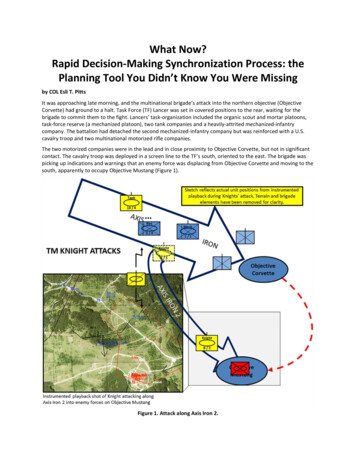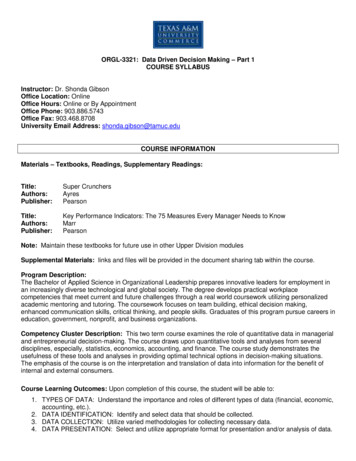
Transcription
What Now?Rapid Decision-Making Synchronization Process: thePlanning Tool You Didn’t Know You Were Missingby COL Esli T. PittsIt was approaching late morning, and the multinational brigade’s attack into the northern objective (ObjectiveCorvette) had ground to a halt. Task Force (TF) Lancer was set in covered positions to the rear, waiting for thebrigade to commit them to the fight. Lancers’ task-organization included the organic scout and mortar platoons,task-force reserve (a mechanized platoon), two tank companies and a heavily-attrited mechanized-infantrycompany. The battalion had detached the second mechanized-infantry company but was reinforced with a U.S.cavalry troop and two multinational motorized rifle companies.The two motorized companies were in the lead and in close proximity to Objective Corvette, but not in significantcontact. The cavalry troop was deployed in a screen line to the TF’s south, oriented to the east. The brigade waspicking up indications and warnings that an enemy force was displacing from Objective Corvette and moving to thesouth, apparently to occupy Objective Mustang (Figure 1).Figure 1. Attack along Axis Iron 2.
At 1145, after hearing some traffic on the brigade command net, Lancer 6 calls Black Knight 6: “Knight 6, beprepared to move south on Axis Iron 2 on order.” (Knights’ combat power consists of eight tanks and threeBradleys.)At 1215, Lancer takes advantage of the lull in the brigade attack to refuel the companies. They direct the priority offueling as Axe (mech) and then Dragon (tank). Knight had only drawn 1,600 gallons of fuel prior to the operation,which had not topped them off. Now, even though they have been running for more than five hours and had justreceived word to be prepared to conduct an attack, they are not part of the refueling plan.At 1253, Lancer 5 and Lancer 6 discuss the situation, and their consensus is that Knight will move south on AxisIron 2 and regain contact with enemy before they can reinforce Objective Mustang.At 1309, Knight starts movement down Axis Iron 2 toward Objective Mustang, passing within 800 meters ofLancer’s fuelers and 3,150 gallons of fuel. Knight is reinforced by Lancer 3 and Lancer 6, who leave the other fivecompanies in the TF behind. Shortly after starting movement on Axis Iron 2, Knight makes contact with enemyvehicles and obstacles.At 1314, Knight 6 backbriefs Lancer elements: “My task and purpose is to go all the way to seize Objective Mustangif my combat power allows it.” He is corrected by Lancer 5: “Conduct a movement-to-contact to defeat that force;no need to enter Objective Mustang.”At 1420, Knight continues the attack and finds itself in heavy contact in the vicinity of Objective Mustang. Knightsustains significant combat losses while achieving minimal effects on the enemy force. Also, while it was irrelevantto the notionally dead vehicles, Lancer wound up with a significant real-world refueling issue for the scatteredcombat vehicles after the attack.At 1725, TF Lancer initiated a second, mostly unplanned, company-level attack into Objective Mustang. This timethey used Team Griffin, a multinational motorized company, and a platoon or so of U.S. mechanized forces. It waswinter and darkness had fallen, but Griffin had minimal training, equipment or capability to operate at night.Lancer’s failure to establish common direct-fire-control measures (DFCMs) on Objective Mustang meant that theUnited States and multinational forces could not coordinate direct fires, preventing the mechanized force fromsupporting Griffin, which was literally operating in the dark. Griffin’s aggression enabled it to achieve a foothold onObjective Mustang; however, the results were again predictable. This time, instead of casualties and a fuel issuefor the tanks, TF Lancer was presented with a dilemma in casualty evacuation, which was cut short as JointMultinational Readiness Center (JMRC) initiated change of mission.Though Lancer had about two hours and 20 minutes to prepare for this significant change of mission, theylaunched Knight without the benefit of updated graphics, direct-fires planning, a battalion fire-support plan orinformation-collection (IC) plan. When it arrived at Objective Mustang, Knight’s tanks had been running for at leastseven hours, but as the battalion’s new main effort, they were not prioritized for refueling even though refuelingoperations were ongoing. Acknowledging that there was still a brigade attack, Lancer left behind four othercompanies (and the remnants of a fifth) and did not weight the new attack with mortars, scouts or the reserve. Asa result, first Knight, and then Griffin, were unable to successfully execute the mission.This attack really happened. I observed it at JMRC while serving as the task-force senior maneuver trainer. Thenames have been changed, but the essential facts played out as described even though the platoons, companiesand battalion were filled with Soldiers who were trained, engaged, cared and wanted to win. Much like your ownformation!How did this happen? How could they have done better? More importantly, how can you keep this fromhappening to you during your next rotation, wherever or whenever that may be?RDSPMost of us have been hearing some variation of the phrases “You were wedded to your plan” or “You fought theplan, not the enemy” for much of our careers. However, there is a doctrinal method by which we can avoid thetyranny of “fighting the plan.” The secret is called the Rapid Decision-Making Synchronization Process (RDSP).
I first heard of RDSP as a student at the Command and General Staff College (CGSC). I’ll admit I didn’t grasp itsimportance until I later served as an instructor there, when I actually taught the class. During my own battalioncommand, I incorporated an iteration into several of the battalion-level training events we conducted andemployed it with good effects during a brigade defense at the National Training Center. As a trainer at JMRC, Ioffered a class to rotational units prior to rolling into the box and also made it a point of emphasis during afteraction reviews.RDSP is still current doctrine, as found in Army Doctrinal Reference Publication (ADRP) 5-0, The OperationsProcess, and to the extent that it is emphasized by individual instructors, it is part of the Advanced OperationsCourse at CGSC.So what is RDSP? And how does it work? This article will review the five steps to RDSP and talk about some ways toimplement it in training.Figure 2. RDSP model.Step 1: compare current situation to orderRDSP is a natural transition from the fourth step in the operations process: “assess.” As we assess an ongoingoperation, we are constantly comparing our actual current and likely future progress to what we anticipated inplanning and preparation and looking for variance between them.Information identified as variance often meets the definition of exceptional information, defined as “informationthat would have answered one of the commander’s critical information requirements [CCIR] if the requirement forit had been foreseen and stated as one of the [CCIRs].”1While this step says we are comparing the current situation to the order, we are actually comparing our currentsituation to a variety of inputs. Certainly the order is the source of some key products, including execution,synchronization and decision matrices. But we can (and should) consider our running estimates and ourunderstanding of aspects of time/distance analysis, and compare our progress to reporting from adjacent andhigher units.Anybody might recognize variance. Consider the following situations: The flank-guard platoon leader just identified the regimental commander’s tank and some commandvehicles under nets on his left flank.
The support force just reported there are no obstacles in the enemy’s main defensive area – at least notwhere templated.The breach force just lost its third mine plow and the roller was already gone.The scouts report that the enemy is 2,500 meters farther east than the graphics show.The battle captain realizes your lead company is 30 minutes behind the timeline.The S-2 plots a unique high-value enemy asset in an unexpected but accessible location.You are executing a decision, branch or contingency plan that was not already planned in detail.The battle noncommissioned officer recognizes that the main-effort company doesn’t have enoughcombat power to achieve the decisive operation.The executive officer realizes that the adjacent battalion is moving fast and there is now a 45-minute gap.Your higher headquarters has just directed you to attack to a new objective in response to a shiftingenemy force (see the opening vignette).These examples all sound overly obvious. My experience, however, is that in the noise and confusion of maneuver,the subtleties of key reporting are often missed or misunderstood. The information was sent, but nobodyrecognized the significance of it.For instance, when I served as battle captain during a brigade attack at Hohenfels, my new radio-telephoneoperator (RTO) received a timely report of an “AT8” (anti-tank system) but recorded it as a report of an “88”(recovery vehicle) at a particular grid. Not recognizing the significance of a reported “88,” the spot report died athis station. The AT8 crew quickly went on to destroy most of a company.Identifying variance is meaningless if somebody doesn’t take action on it. Essential to this step is that somebodythen says something, whether that’s a net call or announcing “Attention in the TOC [tactical-operations center]!”Inexperienced units rarely see the variance until it comes out in the after-action review (AAR). Good unitsrecognize variance as it emerges through constant comparison of the situation to multiple sources: the synchmatrix, the commander’s estimate, battle-tracking, situation reports and gut feelings. Great units recognizevariance and conduct RDSP to quickly identify and analyze the problem, and then create a fragmentary order(FRAGO) to disseminate the solution.The key to success with RDSP lies in the recognition of variance early enough to make a decision with enough timeto execute it against a live enemy force.Step 2: determine the type of decision requiredThere are two essential decisions to make. The first decision is whether to act at all. Variance can present itself inthe form of threats or opportunities. In most if not all cases, the unit must respond to threats to missionaccomplishment or threats to the force, while lesser threats might be ignored. At minimum, the commander mustbalance the risk of not taking action. The unit also may or may not choose to take advantage of opportunities. Forinstance, a battalion conducting an attack on a force-oriented objective might choose to instead take advantage ofa significant terrain-based opportunity. Whether or not it does so, the unit should recognize the opportunity andmake a deliberate decision.The second decision is one of a matter of degree of change. Variance may only require a small change to the plan,called an execution decision. Execution decisions are generally within the existing concept of operations, and thosedecisions may have been delegated to the staff, the TOC, etc. Execution decisions can also involve conductingbranch plans or contingency plans that were already developed to support anticipated commander’s decisions perthe decision-support matrix. Changes that are more complex, involving major changes to the course of action(CoA), are called adjustment changes. Adjustment decisions are generally the result of unanticipated events. Theywill, at minimum, require approval from the unit commander and may require approval of the next-highercommander as well.The line between execution decisions and adjustment decisions is pretty blurred. Decisions should be evaluated interms of a graduated scale of complexity. Maybe the necessary decision was for the battle captain to approve atemporary boundary change, with associated unit crosstalk and updated graphics in the TOC, at which time theprocess was done. At some point, factoring in experience, willingness to delegate and staff proficiency, decisions
rapidly become the commander’s responsibility. Eventually, they become complex enough that they requireconducting the next step.Step 3: develop a CoAThough this is starting to sound like the military decision-making process (MDMP), it is not MDMP. ADRP 5-0 saysthe following: “While [MDMP] seeks the optimal solution, RDSP seeks a timely and effective solution.”2 One keydifference is that the start point of RDSP is the actual situation the unit finds itself in when variance was firstobserved and the need for a decision was identified. You are subject to the very real constraints presented by youravailable combat power, logistical status and disposition on the battlefield.By its very nature, it starts as a reactive event. From that point, the CoA could be one directed by the commander,a hasty product developed in the TOC after a quick “two-minute drill” with the executive officer and then crosstalked between the tactical command post (TAC) and TOC, or a detailed and entirely new plan.Some initial considerations include whether the mission, commander’s intent, CCIRs, decisive operation, shapingoperations and potential decisions need to be changed. Do graphics require changing? Do we need to change thetask-organization, allocate a reserve, reconstitute a reserve or shift the main effort?More advanced: what are the ramifications of your changes on your higher headquarters? As an example: what ifyou change your scheme of fires and update your high-payoff target list (HPTL)? Be aware that your changes, andrequested support, might significantly impact your higher headquarters’ deep fight, either through inadvertentlyduplicating their efforts, or more likely by creating a gap in their plans through diverted assets.The CoA might be as simple as a change to the scheme of
Rapid Decision-Making Synchronization Process: the Planning Tool You Didn’t Know You Were Missing by COL Esli T. Pitts It was approaching late morning, and the multinational brigade’s attack into the northern objective (Objective Corvette) had ground to a halt. Task Force (TF) Lancer was set in covered positions to the rear, waiting for the brigade to commit them to the fight. Lancers .











